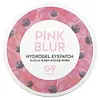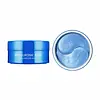What's inside
What's inside
 Key Ingredients
Key Ingredients

 Benefits
Benefits

 Concerns
Concerns

 Ingredients Side-by-side
Ingredients Side-by-side

Water
Skin ConditioningGlycerin
HumectantButylene Glycol
HumectantChondrus Crispus Powder
AbrasiveCeratonia Siliqua Gum
EmollientRubus Fruticosus Fruit Extract
AstringentSambucus Nigra Fruit Extract
AstringentVaccinium Angustifolium Fruit Extract
Skin ProtectingRubus Idaeus Fruit Extract
AstringentVaccinium Macrocarpon Fruit Extract
AstringentCornus Officinalis Fruit Extract
Skin ConditioningPrunus Serotina Fruit Extract
MaskingPunica Granatum Fruit Extract
AntioxidantCamellia Japonica Flower Extract
EmollientBrassica Napus Extract
Skin ConditioningFreesia Refracta Extract
Skin ConditioningOenothera Biennis Flower Extract
AstringentForsythia Suspensa Fruit Extract
AntioxidantCalendula Officinalis Flower Extract
MaskingBrassica Oleracea Italica Extract
AstringentSolanum Lycopersicum Fruit Extract
AntioxidantBrassica Oleracea Capitata Leaf Extract
Skin ConditioningNelumbo Nucifera Flower Water
TonicEucalyptus Globulus Leaf Extract
PerfumingOriganum Vulgare Leaf Extract
Skin ConditioningHibiscus Sabdariffa Flower Extract
Skin ConditioningHedera Helix Leaf Extract
Skin ConditioningCamellia Sinensis Leaf Extract
AntimicrobialLinum Usitatissimum Seed Extract
PerfumingSalvia Hispanica Seed Extract
EmollientPinus Sylvestris Leaf Extract
TonicPyrus Communis Fruit Extract
Skin ConditioningAstaxanthin
Skin ConditioningBetaine
HumectantAdenosine
Skin ConditioningAllantoin
Skin ConditioningPEG-60 Hydrogenated Castor Oil
EmulsifyingCyamopsis Tetragonoloba Gum
Emulsion StabilisingRicinus Communis Seed Oil
MaskingCalcium Chloride
AstringentSynthetic Fluorphlogopite
Titanium Dioxide
Cosmetic ColorantCalcium Aluminum Borosilicate
Tin Oxide
AbrasiveCI 75470
Cosmetic ColorantScutellaria Baicalensis Root Extract
AstringentEthylhexylglycerin
Skin ConditioningGlyceryl Caprylate
EmollientChlorphenesin
AntimicrobialMethylparaben
PreservativeDisodium EDTA
Parfum
MaskingWater, Glycerin, Butylene Glycol, Chondrus Crispus Powder, Ceratonia Siliqua Gum, Rubus Fruticosus Fruit Extract, Sambucus Nigra Fruit Extract, Vaccinium Angustifolium Fruit Extract, Rubus Idaeus Fruit Extract, Vaccinium Macrocarpon Fruit Extract, Cornus Officinalis Fruit Extract, Prunus Serotina Fruit Extract, Punica Granatum Fruit Extract, Camellia Japonica Flower Extract, Brassica Napus Extract, Freesia Refracta Extract, Oenothera Biennis Flower Extract, Forsythia Suspensa Fruit Extract, Calendula Officinalis Flower Extract, Brassica Oleracea Italica Extract, Solanum Lycopersicum Fruit Extract, Brassica Oleracea Capitata Leaf Extract, Nelumbo Nucifera Flower Water, Eucalyptus Globulus Leaf Extract, Origanum Vulgare Leaf Extract, Hibiscus Sabdariffa Flower Extract, Hedera Helix Leaf Extract, Camellia Sinensis Leaf Extract, Linum Usitatissimum Seed Extract, Salvia Hispanica Seed Extract, Pinus Sylvestris Leaf Extract, Pyrus Communis Fruit Extract, Astaxanthin, Betaine, Adenosine, Allantoin, PEG-60 Hydrogenated Castor Oil, Cyamopsis Tetragonoloba Gum, Ricinus Communis Seed Oil, Calcium Chloride, Synthetic Fluorphlogopite, Titanium Dioxide, Calcium Aluminum Borosilicate, Tin Oxide, CI 75470, Scutellaria Baicalensis Root Extract, Ethylhexylglycerin, Glyceryl Caprylate, Chlorphenesin, Methylparaben, Disodium EDTA, Parfum
Water
Skin ConditioningGlycerin
HumectantDipropylene Glycol
HumectantChondrus Crispus
MaskingCeratonia Siliqua Gum
EmollientButylene Glycol
HumectantGlucose
HumectantSodium Hyaluronate
HumectantPotassium Chloride
Pearl Powder
Hydroxyethylcellulose
Emulsion StabilisingCollagen
MoisturisingCyamopsis Tetragonoloba Gum
Emulsion StabilisingEthylhexylglycerin
Skin ConditioningDisodium EDTA
Parfum
MaskingCitrus Unshiu Peel Extract
MaskingAloe Barbadensis Leaf Extract
EmollientCamellia Sinensis Leaf Extract
AntimicrobialAlgae Extract
EmollientRose Extract
Skin ConditioningAnthemis Nobilis Flower Extract
MaskingPunica Granatum Fruit Extract
AntioxidantMelaleuca Alternifolia Leaf Water
AntimicrobialEucalyptus Globulus Leaf Extract
PerfumingGlycine Soja Phytoplacenta Extract
Skin ConditioningCI 77499
Cosmetic ColorantWater, Glycerin, Dipropylene Glycol, Chondrus Crispus, Ceratonia Siliqua Gum, Butylene Glycol, Glucose, Sodium Hyaluronate, Potassium Chloride, Pearl Powder, Hydroxyethylcellulose, Collagen, Cyamopsis Tetragonoloba Gum, Ethylhexylglycerin, Disodium EDTA, Parfum, Citrus Unshiu Peel Extract, Aloe Barbadensis Leaf Extract, Camellia Sinensis Leaf Extract, Algae Extract, Rose Extract, Anthemis Nobilis Flower Extract, Punica Granatum Fruit Extract, Melaleuca Alternifolia Leaf Water, Eucalyptus Globulus Leaf Extract, Glycine Soja Phytoplacenta Extract, CI 77499
Ingredients Explained
These ingredients are found in both products.
Ingredients higher up in an ingredient list are typically present in a larger amount.
Butylene Glycol (or BG) is used within cosmetic products for a few different reasons:
Overall, Butylene Glycol is a safe and well-rounded ingredient that works well with other ingredients.
Though this ingredient works well with most skin types, some people with sensitive skin may experience a reaction such as allergic rashes, closed comedones, or itchiness.
Learn more about Butylene GlycolCamellia Sinensis Leaf Extract is derived from the leaves of the tea plant. Black tea, green tea, and oolong tea are all harvested from this plant.
This ingredient has many skin benefits:
This ingredient contains polyphenols, a strong antioxidant. Antioxidants help fight off molecules that damage skin cells.
On top of that, the antioxidants in green tea neutralize free-radicals from the sun. This gives the skin some extra UV protection, but should not replace sunscreen.
Many components of tea have anti-inflammatory properties.
Polyphenols and L-theanine help soothe the skin and reduce irritation. The caffeine in Camellia Sinensis Leaf Extract helps calm inflamed blood vessels.
Other compounds found in tea include: Vitamin Bs, linoleic acid, magnesium, calcium, iron, and zinc.
Research has shown both drinking Camellia Sinensis Leaf Tea and applying it to the skin can help boost skin elasticity and hydration. Studies also show using tea extract may reduce sebum, or oil, production.
Learn more about Camellia Sinensis Leaf ExtractCeratonia Siliqua Gum is extracted from the seeds of the carob tree. You might know this ingredient as Carob Gum or Locust Bean Gum. It is used to stabilize other ingredients and improve the texture of products.
Carob gum is made up of long-chain polysaccharides. This makes it a natural thickener.
Yes! This ingredient comes from the seeds of a tree. The name 'Locust Bean Gum' can be misleading.
Learn more about Ceratonia Siliqua GumGuar gum is made from the guar bean, a plant native to India. It is considered a form of polysaccharide and naturally contains sugar.
This ingredient is often used to thicken a product or create a gel-like consistency.
It also has emulsion properties to help keep ingredients together.
Learn more about Cyamopsis Tetragonoloba GumDisodium EDTA plays a role in making products more stable by aiding other preservatives.
It is a chelating agent, meaning it neutralizes metal ions that may be found in a product.
Disodium EDTA is a salt of edetic acid and is found to be safe in cosmetic ingredients.
Learn more about Disodium EDTAEthylhexylglycerin (we can't pronounce this either) is commonly used as a preservative and skin softener. It is derived from glyceryl.
You might see Ethylhexylglycerin often paired with other preservatives such as phenoxyethanol. Ethylhexylglycerin has been found to increase the effectiveness of these other preservatives.
Eucalyptus globulus leaf extract comes from the leaves of the blue gum tree. It has perfuming and skin conditioning properties.
According to a manufacturer, this ingredient has antioxidants to help protect skin against free radicals.
This ingredient is water-soluble.
Learn more about Eucalyptus Globulus Leaf ExtractGlycerin is already naturally found in your skin. It helps moisturize and protect your skin.
A study from 2016 found glycerin to be more effective as a humectant than AHAs and hyaluronic acid.
As a humectant, it helps the skin stay hydrated by pulling moisture to your skin. The low molecular weight of glycerin allows it to pull moisture into the deeper layers of your skin.
Hydrated skin improves your skin barrier; Your skin barrier helps protect against irritants and bacteria.
Glycerin has also been found to have antimicrobial and antiviral properties. Due to these properties, glycerin is often used in wound and burn treatments.
In cosmetics, glycerin is usually derived from plants such as soybean or palm. However, it can also be sourced from animals, such as tallow or animal fat.
This ingredient is organic, colorless, odorless, and non-toxic.
Glycerin is the name for this ingredient in American English. British English uses Glycerol/Glycerine.
Learn more about GlycerinParfum is a catch-all term for an ingredient or more that is used to give a scent to products.
Also called "fragrance", this ingredient can be a blend of hundreds of chemicals or plant oils. This means every product with "fragrance" or "parfum" in the ingredients list is a different mixture.
For instance, Habanolide is a proprietary trade name for a specific aroma chemical. When used as a fragrance ingredient in cosmetics, most aroma chemicals fall under the broad labeling category of “FRAGRANCE” or “PARFUM” according to EU and US regulations.
The term 'parfum' or 'fragrance' is not regulated in many countries. In many cases, it is up to the brand to define this term.
For instance, many brands choose to label themselves as "fragrance-free" because they are not using synthetic fragrances. However, their products may still contain ingredients such as essential oils that are considered a fragrance by INCI standards.
One example is Calendula flower extract. Calendula is an essential oil that still imparts a scent or 'fragrance'.
Depending on the blend, the ingredients in the mixture can cause allergies and sensitivities on the skin. Some ingredients that are known EU allergens include linalool and citronellol.
Parfum can also be used to mask or cover an unpleasant scent.
The bottom line is: not all fragrances/parfum/ingredients are created equally. If you are worried about fragrances, we recommend taking a closer look at an ingredient. And of course, we always recommend speaking with a professional.
Learn more about ParfumYou might know this ingredient as pomegranate fruit. It has been shown to have antioxidant, skin soothing and anti-aging benefits.
Pomegranates are rich in antioxidant compounds such as polyphenolic compounds such as ellagic acid, phenolic acids, anthocyanins, and flavonoids.
Both in-vivo and in-vitro studies show pomegranate fruit helps with:
These benefits offer skin anti-aging and skin soothing benefits.
Fun fact: The name pomegranate comes from two latin words: "pome" or apple, and "granate" or "many seeded".
Pomegranate flower extract is often confused for pomegranate fruit extract, but comes from the flowers of the tree.
Learn more about Punica Granatum Fruit ExtractWater. It's the most common cosmetic ingredient of all. You'll usually see it at the top of ingredient lists, meaning that it makes up the largest part of the product.
So why is it so popular? Water most often acts as a solvent - this means that it helps dissolve other ingredients into the formulation.
You'll also recognize water as that liquid we all need to stay alive. If you see this, drink a glass of water. Stay hydrated!
Learn more about Water